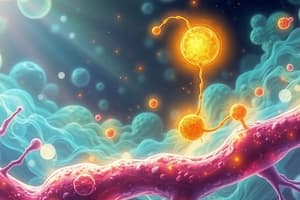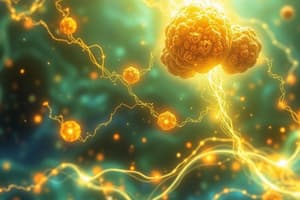Podcast
Questions and Answers
Which process produces 3 ATP during carbohydrate metabolism?
Which process produces 3 ATP during carbohydrate metabolism?
What type of bond in ATP is considered a high-energy bond?
What type of bond in ATP is considered a high-energy bond?
What is the primary source of energy for oxidative phosphorylation?
What is the primary source of energy for oxidative phosphorylation?
Which substrate is directly used in glycolysis to produce pyruvate?
Which substrate is directly used in glycolysis to produce pyruvate?
Signup and view all the answers
Which of the following is a fate of glucose in the liver?
Which of the following is a fate of glucose in the liver?
Signup and view all the answers
Where does glycolysis primarily occur in the cell?
Where does glycolysis primarily occur in the cell?
Signup and view all the answers
What is a characteristic of glycolysis in red blood cells?
What is a characteristic of glycolysis in red blood cells?
Signup and view all the answers
Which of the following best describes the function of gluconeogenesis?
Which of the following best describes the function of gluconeogenesis?
Signup and view all the answers
What activates glucose in the glycolysis pathway?
What activates glucose in the glycolysis pathway?
Signup and view all the answers
Which enzyme is present in all extrahepatic cells?
Which enzyme is present in all extrahepatic cells?
Signup and view all the answers
What is the main function of glucokinase?
What is the main function of glucokinase?
Signup and view all the answers
How does hexokinase differ from glucokinase regarding glucose affinity?
How does hexokinase differ from glucokinase regarding glucose affinity?
Signup and view all the answers
Which location is glucokinase specifically found in?
Which location is glucokinase specifically found in?
Signup and view all the answers
What is one characteristic of hexokinase?
What is one characteristic of hexokinase?
Signup and view all the answers
Which of the following statements is true regarding the activation of glucose?
Which of the following statements is true regarding the activation of glucose?
Signup and view all the answers
Which statement correctly describes the irreversibility of glucose activation?
Which statement correctly describes the irreversibility of glucose activation?
Signup and view all the answers
What is the primary function of glucose-6-phosphate in energy metabolism?
What is the primary function of glucose-6-phosphate in energy metabolism?
Signup and view all the answers
Which enzyme is responsible for the conversion of glucose-6-phosphate to fructose-6-phosphate?
Which enzyme is responsible for the conversion of glucose-6-phosphate to fructose-6-phosphate?
Signup and view all the answers
What is the role of phosphofructokinase 1 in glycolysis?
What is the role of phosphofructokinase 1 in glycolysis?
Signup and view all the answers
Aldolase A is primarily found in which type of tissue?
Aldolase A is primarily found in which type of tissue?
Signup and view all the answers
What is produced when fructose-1,6-diphosphate is cleaved by aldolases?
What is produced when fructose-1,6-diphosphate is cleaved by aldolases?
Signup and view all the answers
Which enzyme catalyzes the interconversion of triose phosphates?
Which enzyme catalyzes the interconversion of triose phosphates?
Signup and view all the answers
What effect does fasting or diabetes have on the rate of activity of glucose-6-phosphate?
What effect does fasting or diabetes have on the rate of activity of glucose-6-phosphate?
Signup and view all the answers
What is required for the activation of fructose-6-phosphate by phosphofructokinase 1?
What is required for the activation of fructose-6-phosphate by phosphofructokinase 1?
Signup and view all the answers
What is the role of glyceraldehyde-3-phosphate dehydrogenase in the conversion of glyceraldehyde-3-phosphate?
What is the role of glyceraldehyde-3-phosphate dehydrogenase in the conversion of glyceraldehyde-3-phosphate?
Signup and view all the answers
What is the significance of the reaction catalyzed by phosphoglycerate kinase?
What is the significance of the reaction catalyzed by phosphoglycerate kinase?
Signup and view all the answers
What is the total ATP gained during the aerobic oxidation of one mole of glucose?
What is the total ATP gained during the aerobic oxidation of one mole of glucose?
Signup and view all the answers
What occurs during the action of phosphoglycerate mutase?
What occurs during the action of phosphoglycerate mutase?
Signup and view all the answers
Under anaerobic conditions, what is the net ATP gained from the oxidation of one mole of glucose into lactate?
Under anaerobic conditions, what is the net ATP gained from the oxidation of one mole of glucose into lactate?
Signup and view all the answers
Which of the following statements about enolase enzyme is true?
Which of the following statements about enolase enzyme is true?
Signup and view all the answers
Which of the following is NOT a key regulatory enzyme in glycolysis?
Which of the following is NOT a key regulatory enzyme in glycolysis?
Signup and view all the answers
What is the result of the reaction catalyzed by aldolase?
What is the result of the reaction catalyzed by aldolase?
Signup and view all the answers
How does insulin affect glycolysis?
How does insulin affect glycolysis?
Signup and view all the answers
Which cofactor is essential for the reaction converting 1,3-diphosphoglycerate into 3-phosphoglycerate?
Which cofactor is essential for the reaction converting 1,3-diphosphoglycerate into 3-phosphoglycerate?
Signup and view all the answers
What is the end product of glycolysis under anaerobic conditions?
What is the end product of glycolysis under anaerobic conditions?
Signup and view all the answers
In what type of phosphorylation does phosphoglycerate kinase participate?
In what type of phosphorylation does phosphoglycerate kinase participate?
Signup and view all the answers
Which of the following substances can inhibit glycolysis in vitro?
Which of the following substances can inhibit glycolysis in vitro?
Signup and view all the answers
What is the main difference in energy yield from aerobic versus anaerobic glycolysis?
What is the main difference in energy yield from aerobic versus anaerobic glycolysis?
Signup and view all the answers
What roles do NAD and inorganic phosphate play in the reaction involving glyceraldehyde-3-phosphate?
What roles do NAD and inorganic phosphate play in the reaction involving glyceraldehyde-3-phosphate?
Signup and view all the answers
Which hormones are known to inhibit glycolysis?
Which hormones are known to inhibit glycolysis?
Signup and view all the answers
What compound is produced when arsenate replaces inorganic phosphate in the reaction catalyzed by glyceraldehyde-3-phosphate dehydrogenase?
What compound is produced when arsenate replaces inorganic phosphate in the reaction catalyzed by glyceraldehyde-3-phosphate dehydrogenase?
Signup and view all the answers
What is the end product of glycolysis in mature red blood cells?
What is the end product of glycolysis in mature red blood cells?
Signup and view all the answers
Which enzyme is inhibited by iodoacetate?
Which enzyme is inhibited by iodoacetate?
Signup and view all the answers
What is a link between glycolysis and amino acid metabolism?
What is a link between glycolysis and amino acid metabolism?
Signup and view all the answers
Which role does 2,3-diphosphoglycerate (2,3-DPG) serve in the body?
Which role does 2,3-diphosphoglycerate (2,3-DPG) serve in the body?
Signup and view all the answers
What is produced during the hydrolysis of the phosphate group from 2,3-diphosphoglycerate?
What is produced during the hydrolysis of the phosphate group from 2,3-diphosphoglycerate?
Signup and view all the answers
Which of the following statements about glucose uptake in RBCs is true?
Which of the following statements about glucose uptake in RBCs is true?
Signup and view all the answers
What is the primary effect of fluoride on the glycolytic pathway?
What is the primary effect of fluoride on the glycolytic pathway?
Signup and view all the answers
Study Notes
Carbohydrate Metabolism
- Carbohydrate metabolism is a complex process involving the breakdown, synthesis, and transformation of carbohydrates in the body.
- Fructose, galactose, and mannose are converted to glucose in the liver.
- Glucose can follow different metabolic pathways.
- Oxidative fates include glycolysis and the Krebs cycle, and the pentose shunt.
- Anabolic fates include glycogen synthesis/breakdown and gluconeogenesis.
ATP Production
- Chemical bonds are classified as high-energy and low-energy based on the free energy released during hydrolysis.
- High-energy bonds (e.g., β and γ-phosphate bonds in ATP) release more than 7000 calories per bond.
- Low-energy bonds (e.g., α-phosphate bond in ATP) release less than 4000 calories per bond.
- ATP is produced via two main processes: oxidative phosphorylation and substrate-level phosphorylation.
- Oxidative phosphorylation utilizes energy released from the transfer of electrons from NADH/FADH₂ to oxygen via the electron transport chain.
- Substrate-level phosphorylation directly transfers high-energy phosphate groups to ADP from a high-energy substrate.
Glycolysis
- Glycolysis is the Embden-Meyerhof pathway, a series of reactions converting glucose into pyruvate. This process occurs within the cell cytoplasm in all tissues.
- In the presence of oxygen, glycolysis produces pyruvate, which is further oxidized in mitochondria.
- In the absence of oxygen, pyruvate is converted into lactate.
- RBCs depend solely on glycolysis for energy as they lack mitochondria, and lactate is always the end product.
- The uptake of glucose in RBCs is independent of insulin.
- Glycolysis produces NADH+H+, used in reducing met-hemoglobin in RBCs by the cytochrome b5-methemoglobin reductase system.
Key Glycolysis Enzymes and Regulation
- Glycolysis is regulated by key enzymes, including phosphofructokinase-1, hexokinase, and pyruvate kinase.
- Insulin stimulates the synthesis of these enzymes, fostering glycolysis.
- Adrenaline and glucagon inhibit pyruvate kinase, thus suppressing glycolysis.
Glycolysis Inhibition in Vitro
- In vitro inhibition of glycolysis: 2-deoxyglucose inhibits hexokinase and glucokinase
- Arsenate substitutes inorganic phosphate, resulting in an unstable intermediate.
- Iodoacetate inhibits glyceraldehyde-3-phosphate dehydrogenase, a crucial enzyme in glycolysis.
- Fluoride inhibits enolase.
Biological Importance of Glycolysis
- Glucose oxidation is a major energy source for RBCs and skeletal muscles, producing ATP.
- Glycolysis provides the pyruvic acid required for the Krebs cycle.
- It connects carbohydrate metabolism with fat metabolism (conversion of dihydroxyacetone phosphate into glycerol-3-phosphate), and with amino acid metabolism (conversion of 3-phosphoglycerate into serine and pyruvate to alanine).
Rapoport-Lubering Cycle
- The Rapoport-Lubering cycle is a side-pathway in RBCs, producing 2,3-diphosphoglycerate (2,3-DPG).
- 2,3-DPG is crucial in oxygen delivery as it decreases hemoglobin's affinity for oxygen, assisting in oxygen release in tissues.
- 2,3-DPG level in blood decreases during storage thus affecting oxygen transport efficiency.
Studying That Suits You
Use AI to generate personalized quizzes and flashcards to suit your learning preferences.
Related Documents
Description
This quiz explores the intricate processes of carbohydrate metabolism, including the conversion of various sugars to glucose and the different metabolic pathways glucose can follow. Additionally, it covers ATP production methods, highlighting the significance of high-energy and low-energy chemical bonds in energy release.




